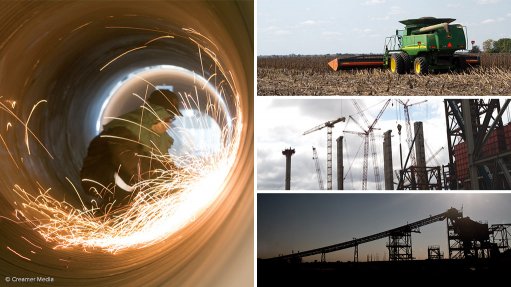
The mining, quarrying and manufacturing industries were the biggest contributors to South Africa’s gross domestic product (GDP) contracting by 0.3% in the fourth quarter of 2016.
“Commodities showed a declining trend. Mining and quarrying decreased by 11.5% owing to a drop in the production of coal, gold and other metals, including platinum,” Statistics South Africa (Stats SA) national accounts chief director Michael Manamela said.
Although the agriculture sector declined by 0.1%, there were signs of improvement.
Manufacturing, meanwhile, decreased by 3.1%, brought on by a decline in manufacturing of food and beverages, petroleum, chemical products, rubber and plastic products, as well as motor vehicles, parts and accessories of transport equipment.
The primary and secondary sectors declined by 9% and 1.8%, while the tertiary sector grew by 1.3%.
The trade, catering and accommodation and finance, real estate and business services sectors had, meanwhile, made the largest positive contributions to GDP in the fourth quarter.
“The quarterly GDP growth performance remains disappointing and highlights the urgent need to address the structural issues and policy uncertainty in key supply-side areas of the economy,” BNP Paribas Securities South Africa economist Jeffrey Schultz said in a statement.
He pointed out that the biggest challenge for policymakers will be raising confidence where the private sector continues to disinvest, which remains a major inhibitor to potential growth and “something which rating agencies will continue to monitor closely.”
“It’s not all ‘doom and gloom’, however, as we are inherently more bullish on the outlook for the global economy than we were a quarter ago, as the ‘Trump trade’, industrial metal reflation and a more stable China have buoyed renewed levels of optimism in the global economic system,” Schultz noted.
Political risk aside, he said the South African economy should be able to benefit from these factors, particularly improving terms of trade, an agriculture sector which looks poised for a rebound, sharply lower inflation in the second half of the year and a lower current account deficit thanks to a greater contribution to growth from net trade.
“We forecast for GDP growth to improve to 1.3% in 2017,” he said.
GDP had expanded by 0.3% in 2016, down from the 1.3% growth in 2015.
The Steel and Engineering Industries Federation of Southern Africa (Seifsa) expressed concern over the “disappointing” GDP figures.
Seifsa senior economist Tafadzwa Chibanguza said that, although concerning, the figures were aligned to the economic climate of 2016. “2016 was undoubtedly a very difficult year that we were relieved to see the back of,” he said.
Chibanguza noted that the 0.3% expansion in the economy for 2016 was essentially no growth.
The metals and engineering sector contracted by 2% in 2016 in what was a very challenging year for the sector.
“However, these numbers must be viewed against the fact that, in 2016, the global economy also expanded by the slowest pace since the 2008/9 recession and all commodity-exporting emerging markets essentially came to a standstill,” he said.
“Mining and quarrying contracted by 11.5% and was the largest negative contributor to the overall GDP growth rate. Seifsa views this with concern because the mining industry accounts for 25% of the metals and engineering sector’s demand profile,” he said.
He added that the 3.1% contraction in the manufacturing sector was of concern.
“This should be particularly worrying for the country because both mining and manufacturing have the highest job absorption properties. The contraction in these sectors spells disaster for the socioeconomic aspects of the economy and the unemployment rate,” Chibanguza noted.